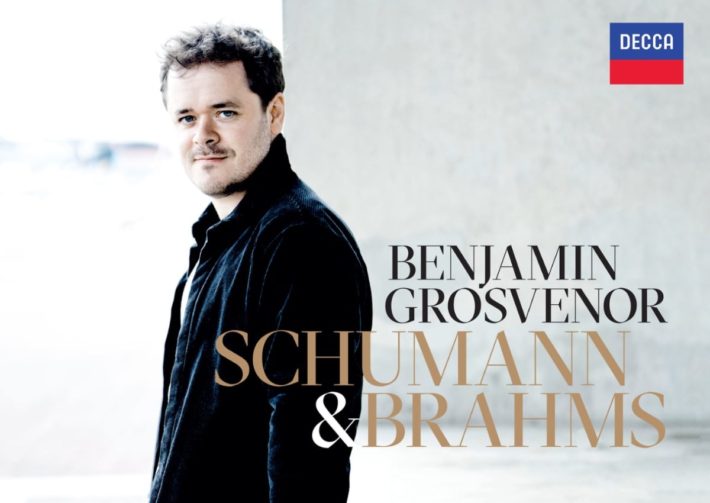If one goes by Benjamin Grosvenor’s recent discs, he has found a home among Romantic composers. We reviewed his 2021 album that centered on Liszt, while his previous outputs have featured Chopin and Franck. His latest effort explores the realms of Schumann (both Clara and Robert) and 3 Brahms Intermezzi.
Like some of Schumann’s other sets, the Op. 16 Kreisleriana has a number of distinct personas. Some mannerisms (i.e. similar rubato patterns) persist, but Grosvenor is generally successful in bringing out these vibrant characters. He presents the drama of the opening work by way of swirling fast notes, pronounced basslines, and an emphasis on the rhapsodic quality. This proves to be a smart musical choice that helps establish a contrast to the coy Sehr Innig that follows. Here, the tone quality also has a satisfying resonance but in a starkly different—more restful—context. Phrases hold shape but have a perceptible ebb and flow. His interpretation does feel more extroverted when we consider other versions such as Radu Lupu’s (Decca): Lupu’s equally fine performance places more focus on nuanced shades of piano dynamics.
Sehr aufgeret (track 3) sees a steadfastness in the galloping right hand patterns that help feed the excitement derived from the biting accents in the left hand. At times, though, the ferocity feels a little overdone and harsh on the ear. The middle section, however, proves inviting in its change of mood and lyricism: Grosvenor takes his time in maximizing the high points of phrases while offering lovely shifts in color as we hear starting at 1’31”. Middle voices are thankfully not ignored— the pianist shows clearly the interchange of voices that allows us to hear the melodic dialogue Schumann creates. The final Schnell und spielend (track 8) has clean enough articulation but listeners may prefer something along the lines of Brendel’s 1992 account: here, the two-groupings are tighter and the soft dynamics more nuanced to truly capture the sprightly yet secretive feel.
Related Posts
- Double Review: Chopin Piano Concertos – Grosvenor, Yundi
- Review: Clara & Robert Schumann – Piano Concertos – Rana, Nézet-Séguin
- Review: Schumann – Fantasy, Kreisleriana – Yeol Eum Son, Piano
I initially found it odd that Grosvenor didn’t feature Schumann’s F minor sonata in its entirety, instead choosing to present only the third movement. Katy Hamilton’s liner notes offers perspective on this choice: this theme-and-variations movement finds its source from Clara Schumann, whose own Op, 20 Variations on a Theme by Robert Schumann appear later on the disc. The liner notes mention that Grosvenor found inspiration growing up with Horowitz’s recording of the movement and the performance certainly attests to this. The tempos are more or less similar and both pianists don’t take the desolate character of the theme to maudlin extremes. There are differences, however: within Horowitz’s lyricism is a sense of guardedness, a reservedness under which perhaps a more personal sense of sadness lies. Grosvenor’s is tinged with more obvious heartache and even a hint of nostalgic sweetness, especially when the melody reaches the upper register. In the first variation, Horowitz upholds the theme in a more pronounced fashion against the meandering lines. Grosvenor’s might not stand out as much but adds more fluctuation in the dynamics, and therefore a touch more dimensionality. The third variation might call to mind the similar rhythms and energetic scampering in the ‘Pantalon and Columbine’ of Schumann’s Op. 9 Carnaval, whereas the final variation is a profoundly declamatory commentary on the tragedy of the entire movement.
The theme of Clara’s Schumann’s Op. 20 Variations bears a strong motivic resemblance to what we heard previously. Where Robert’s F minor opening resembles a funeral-march, Clara’s shift to F# minor adds a poignancy that’s yet tempered by hymnal textures—a delicate relationship that Grosvenor aptly captures through his fine tone quality. The second variation (track 19) encompasses both virtuosity and finesse with the pianist delivering on both ends: the theme maintains a pronounced sostenuto while the intervallic accompaniments are even and well-voiced throughout Variation 4 (track 21) reflects the quintessential “three-hand” technique (also heard in works like Liszt’s ‘Un Sospiro’ Concert Etude). Grosvenor exhibits an effortless facility with the acrobatic arpeggios that envelop the nicely shaped middle-voice theme.
Grosvenor’s affinity and understanding of Romantic-era composers is evident in his solid performances on this album. While he may not deliver the most unique interpretations of these works, his pianism, both technically and musically, is to be acknowledged and appreciated.

Schumannn & Brahms
Benjamin Grosvenor – Piano
Decca, CD 4853945
Recommended Comparisons
Read more classical music reviews or visit The Classic Review Amazon store
Follow Us and Comment:
Get our periodic classical music newsletter with our recent reviews, news and beginners guides.
We respect your privacy.









